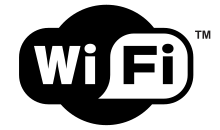Wi Fi

The old Wi-Fi Alliance logo
|
|
| Developed by | Wi-Fi Alliance |
|---|---|
| Introduced | September 1998 |
| Compatible hardware | Mobile phones, personal computers, gaming consoles, televisions |
Wi-Fi or WiFi is a technology for wireless local area networking with devices based on the IEEE 802.11 standards. Wi-Fi is a trademark of the Wi-Fi Alliance, which restricts the use of the term Wi-Fi Certified to products that successfully complete interoperability certification testing.
Devices that can use Wi-Fi technology include personal computers, video-game consoles, smartphones, digital cameras, tablet computers, digital audio players and modern printers. Wi-Fi compatible devices can connect to the Internet via a WLAN and a wireless access point. Such an access point (or hotspot) has a range of about 20 meters (66 feet) indoors and a greater range outdoors. Hotspot coverage can be as small as a single room with walls that block radio waves, or as large as many square kilometres achieved by using multiple overlapping access points.
Wi-Fi most commonly uses the 2.4 gigahertz (12 cm) UHF and 5 gigahertz (6 cm) SHF ISM radio bands. Having no physical connections, it is more vulnerable to attack than wired connections, such as Ethernet.
In 1971, ALOHAnet connected the Hawaiian Islands with a UHF wireless packet network. ALOHAnet and the were early forerunners to Ethernet, and later the IEEE 802.11 protocols, respectively.
A 1985 ruling by the U.S. Federal Communications Commission released the ISM band for unlicensed use. These frequency bands are the same ones used by equipment such as microwave ovens and are subject to interference.
In 1991, NCR Corporation with AT&T Corporation invented the precursor to 802.11, intended for use in cashier systems. The first wireless products were under the name WaveLAN. They are the ones credited with inventing Wi-Fi.
...
Wikipedia
